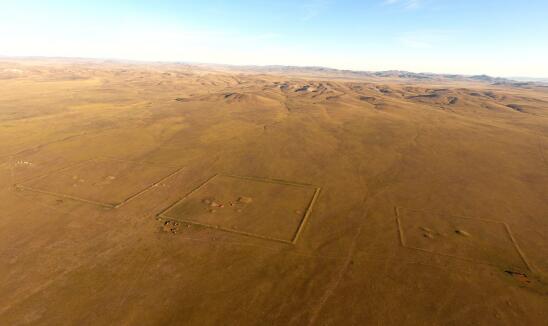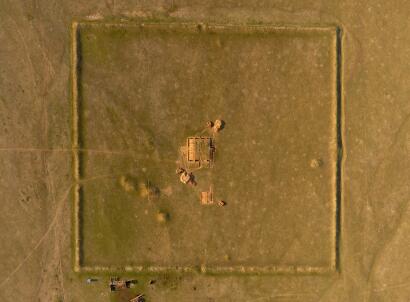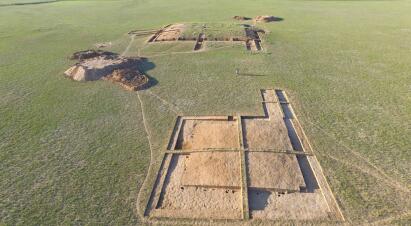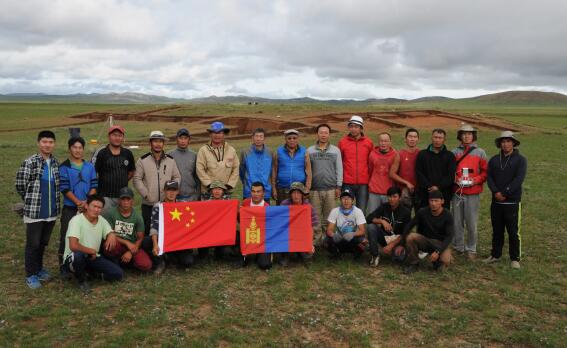Archaeological excavations at the Khermen Tal site in Arkhangai Province, Mongolia
From:Chinese Archaeology NetWriter:Date:2018-01-19
Khermen Tal site is located in Ogiinuur Sum, Arkhangai Province, Mongolia. As one of the best preserved and largest ancient city groups in Mongolia, it contained 3 walled enclosures remains side by side from east to west with same layout. Therefore, it’s so-called “Hudgiyn Denj (Three interconnected cities)”. From 2014 to 2016, a Sino-Mongolian joint archaeological team consists of Inner Mongolian Institute of Cultural Relics and Archaeology and International College of Nomadic Culture of Mongolia conducted archaeological survey, while also undertaking research, exploration and mapping to the site. Some features were cleared up. The Central platforms of west city and middle city, east door of west city and earthen platform in the southwest of middle city were uncovered during the excavations. East wall, a moat and path in west city and etc. were sectioned. Very few artifacts were found from various features and deposits. Only several broken pottery shards were unearthed, so was a copper nail, a copper knife and an iron knife.
The discovery was made in Ogiinuur Sum, Arkhangai Province, Mongolia.

The aerial photo of the “Hudgiyn Denj (Three interconnected cities)”

Middle city's orthographic view
From July to October in 2017, the joint archaeological team cleared up the central platform which is located in the middle of the walled enclosure (numbered as IIA). IIA earthen platform consisted of a covered-bucket-shaped platform, a sloping step-road in the west and a south-north oriented sloping step-road in the east. The platform was south-north oriented and each side was 35.8m long. Around the platform, there were 36 large post-holes being discovered, most of which were round in plane with a 0.75~1.05m long diameter and 0.80~1.00m depth. In their bottoms, there were flat stones as plinth stone. Around large post-holes, there are small post-holes with a 0.15~0.30m diameter and a 0.30~0.60m depth distributed regularly. According to the results of excavations, there was probably a grid structure consisting of 100 large posts, might be a large ritual platform with a 9-room width and a 9 room length. Sloping step road in the west connected to the middle part of the west end of platform. The step road is 14.4m long and 4.2m wide. Sloping step road in the east was 2.6~2.9m wide and 64m long, south-north oriented, and next to a small earth platform (IIB) in the left front of IIA. IIB is south-north oriented and basically square in plane. It’s 13.6m long from east to west and 12.8m wide from south to north. Regularly distributed small post holes were discovered around the platform, too.

Earth platform IIA and IIB

The group photo
“Hudgiyn Denj (three interconnected cities)” is sure to belong to Hsiung-nu period according to stratigraphic, typological analysis and results of C14 dating, which ends the chronology debate of it. Considering documents, it’s preliminarily predicted that the walled enclosure remains are large ritual architectures related to ritual practices of Hsiung-nu, or “shrine” remains for Hsiung-nu’s chiefs or aristocrats. Central platform of middle city of “Hudgiyn Denj” is the first large platform base of a building built by earth and wood completely and uncovered within Mongolia. Thus, it is of important academic value for research on Hsiung-nu archaeology. (Translator: Ma Huanhuan Photo: Archaeology Press IA CASS)

